
United States Joint Forces Command (USJFCOM) was a Unified Combatant Command of the United States Department of Defense. USJFCOM was a functional command that provided specific services to the military. The last commander was Army Gen. Ray Odierno. As directed by the President to identify opportunities to cut costs and rebalance priorities, Defense Secretary Robert Gates recommended that USJFCOM be disestablished and its essential functions reassigned to other unified combatant commands. Formal disestablishment occurred on 4 August 2011.
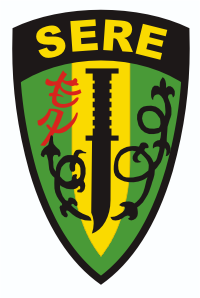
Survival, Evasion, Resistance, and Escape (SERE) is a training program, best known by its military acronym, that prepares U.S. military personnel, U.S. Department of Defense civilians, and private military contractors to survive and "return with honor" in survival scenarios. The curriculum includes survival skills, evading capture, application of the military code of conduct, and techniques for escape from captivity. Formally established by the U.S. Air Force at the end of World War II and the start of the Cold War, it was extended to the Navy and United States Marine Corps and consolidated within the Air Force during the Korean War with greater focus on "resistance training".
The Joint Functional Component Command for Intelligence, Surveillance and Reconnaissance was a subordinate command of the United States Strategic Command, one of the nine Unified Combatant Commands under the United States Department of Defense (DOD) and co-located with the Defense Intelligence Agency (DIA). It served as the center for planning, execution and assessment of the United States military's global Intelligence, Surveillance, and Reconnaissance operations from 2005-2016; a key enabler to achieving global situational awareness. In 2016 JFCC-ISR was realigned to the Joint Staff.
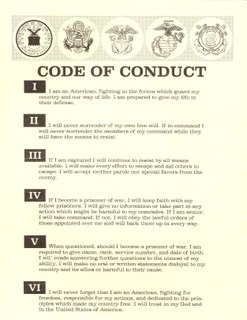
The Code of the U.S. Fighting Force is a code of conduct that is an ethics guide and a United States Department of Defense directive consisting of six articles to members of the United States Armed Forces, addressing how they should act in combat when they must evade capture, resist while a prisoner or escape from the enemy. It is considered an important part of U.S. military doctrine and tradition, but is not formal military law in the manner of the Uniform Code of Military Justice or public international law, such as the Geneva Conventions.

The United States Department of Defense is an executive branch department of the federal government charged with coordinating and supervising all agencies and functions of the government directly related to national security and the United States Armed Forces. The DOD is the largest employer in the world, with over 1.4 million active-duty service members as of 2021. More employees include over 826,000 National Guard and reservists from the armed forces, and over 732,000 civilians bringing the total to over 2.8 million employees. Headquartered at the Pentagon in Arlington, Virginia, just outside Washington, D.C., the DoD's stated mission is to provide "the military forces needed to deter war and ensure our nation's security".

The United States Armed Forces, in Joint Publication 3-50 Personnel Recovery, defines personnel recovery as "the sum of military, diplomatic, and civil efforts to prepare for and execute the recovery and reintegration of isolated personnel."
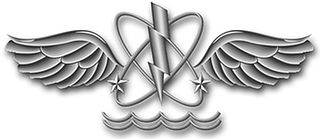
The Naval Aircrewman rating is an enlisted rating of the US Navy. It was previously designated as aviation anti-submarine warfare operator. However, under the CNO-directed "Helicopter Master Plan", all 78XX and 94XX aircrewmen were re-designated as "aviation warfare systems operators". The description of the Naval Aircrew Rate (AW) on this page define only the "Active Duty" aspects of the AW rate, fleets (aircraft), positions, and duties that are manned by aircrew in today's Navy. The Full Time Support (FTS) and Selected Reserves (SELRES) components of the U.S. Naval Reserves make up the largest number of Aircrew in today's Navy. Many technologically advanced navies have a similar trade.

Noble Resolve is a United States Joint Forces Command (USJFCOM) experimentation campaign plan to enhance homeland defense and improve military support to civil authorities in advance of and following natural and man-made disasters.

The Pentagon Police Division (PPD) is the uniformed division of the Pentagon Force Protection Agency (PFPA).
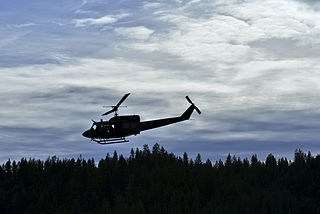
The 336th Training Group is the combat survival training group of the United States Air Force. The group is located at Fairchild Air Force Base, Washington, with one subordinate unit at Naval Air Station Pensacola, Florida, and one at Eielson Air Force Base, Alaska.

Exercise Northern Edge is Alaska's premier military joint training exercise. Alaskan Command (ALCOM) uses expansive Alaskan training ranges to conduct this joint training operation.

United States Department of Defense Police are the uniformed civilian police officers of the United States Department of Defense, various branches of the United States Armed Forces, or specific DoD activities. The DoD Police are responsible for law enforcement and security services on DoD owned and leased buildings, facilities, properties and other DoD assets. It is important to note that "Department of Defense Police" is a catch-all phrase that refers to any civilian engaged in police duties for the Department of Defense and its component branches of the US Armed Forces.

Combat Rescue Officer (CRO) is a career field in the United States Air Force. Its Air Force Specialty Code (AFSC) is 13D and it was created to strengthen USAF personnel recovery capabilities by providing commissioned officer leadership that possessed an operational skillset paralleling that of the enlisted pararescuemen (PJ). The CRO specialty includes direct combatant command and control of Combat Search and Rescue (CSAR) operations. They plan, manage and execute the six tasks of CSAR: prepare, report, locate, support, recover, and reintegrate isolated personnel and materiel. CROs conduct strategic, operational and tactical level planning, provide battle staff expertise, manage theater personnel recovery operations and conduct combat operations.

Department of the Army Civilian Police are the uniformed and plainclothes civilian police officers and detectives of the United States Army. They are also referred to as DoD Police. The Department of the Army Civilian Police (DACP) are responsible for law enforcement on U.S. Army–owned and –leased buildings, facilities, properties and other U.S. Army assets. In overseas locations or in areas of concurrent jurisdiction, Department of the Army Civilian Police are responsible for the protection and policing of DOD-affiliated personnel, performing police liaison work with foreign police agencies, and investigating incidents involving personnel of the U.S. Armed Forces. It is important to note that "Department of Defense Police" is a phrase that refers to any civil service employee engaged in police duties for the Department of Defense and its component branches of the US Armed Forces. There is no one unified agency that goes under the title "Department of Defense Police". There are several police forces that use the title "DoD police", such as the Pentagon Police, Defense Logistics Agency Police, Navy Civilian Police (NCP), Army Civilian Police (DACP), Marine Corps Civilian Police (MCCIVPOL) and Air Force Civilian Police (DAFCP).
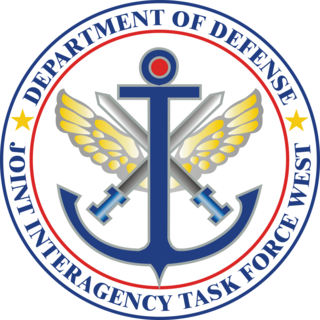
Joint Interagency Task Force West is a standing United States military joint task force with the mission of combating drug-related transnational organized crime in the Indo-Asia-Pacific. JIATF West's area of responsibility (AOR) is that of United States Indo-Pacific Command (USINDOPACOM). JIATF West is one of two Joint Interagency Task Forces with a counter-narcotics mission. The other is Joint Interagency Task Force South. The task force is run as USPACOM's "executive agent" for counterdrug activities providing support to partner nation law enforcement. Approximately 166 active duty and reserve U.S. military forces; Department of Defense civilian employees; contractors; and U.S. and foreign law enforcement agency personnel are members of the task force.

United States Army Counterintelligence (ACI) is the component of United States Army Military Intelligence which conducts counterintelligence activities to detect, identify, assess, counter, exploit and/or neutralize adversarial, foreign intelligence services, international terrorist organizations, and insider threats to the United States Army and U.S. Department of Defense (DoD).

The United States Department of Defense (DoD) has a complex organizational structure. It includes the Army, Navy, the Marine Corps, Air Force, Space Force, the Unified combatant commands, U.S. elements of multinational commands, as well as non-combat agencies such as the Defense Intelligence Agency and the National Security Agency. The DoD's annual budget was roughly US$496.1 billion in 2015. This figure is the base amount and does not include the $64.3 billion spent on "War/Non-War Supplementals". Including those items brings the total to $560.6 billion for 2015.

The Defense Clandestine Service (DCS) is an arm of the Defense Intelligence Agency (DIA), which conducts clandestine espionage activities around the world to answer national-level defense objectives for senior U.S. policymakers and military leaders. Staffed by civilian and military personnel, DCS is part of DIA's Directorate of Operations and works in conjunction with the Central Intelligence Agency's Directorate of Operations and the U.S. military's Joint Special Operations Command. DCS consists of about 500 clandestine operatives, which is roughly how many case officers the CIA maintained in the early 2000s prior to its expansion.

The European Personnel Recovery Centre (EPRC) is an intergovernmental military organisation that contributes to the development and harmonisation of policies and standards related to personnel recovery. The ERPC also provides support for education, training, exercises and operations. The EPRC was established on 8 July 2015 and is based at Poggio Renatico Air Base in Italy.


















